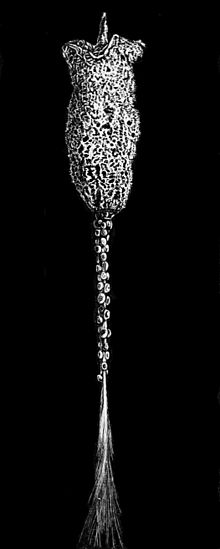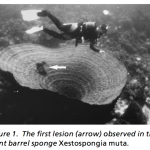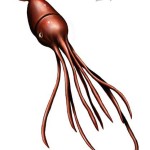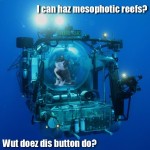
Within the glass sponges (Hexactinellids), so called because of scaffolds of silica spicules they form, resides a family of sponges, the Monorhaphididae. Family here is used in taxonomic sense to delineate substantially different types of organisms. Think the differences between cows and giraffes, both artiodactyls but in different families. But in the common meaning of the term family, Monorhaphididae has the saddest family of all—a family of one. The only species with this family is Monorhaphis chuni first described by by Franz Eilhard Schulze in 1904 from specimens collected by the German Deep Sea Expedition in 1898-1899. But despite this sponge’s lonely existence, it also dwells in the deep depths of the abyss, it lays claim to world record.
 Monorhaphis chuni forms giant spicules that can reach 3 meters in length (~10 ft). These long spicules form the base of sponge putting the business end way up off the bottom to feed. Indeed lots of organism in the deep oceans are stalked or climb atop other stalked organisms to feed in the water off the bottom. Currents very near the bottom are sluggish because of friction of the water against the seafloor. Getting up into the water column gives an animal access to stronger currents carrying both oxygen and particles of food.
Monorhaphis chuni forms giant spicules that can reach 3 meters in length (~10 ft). These long spicules form the base of sponge putting the business end way up off the bottom to feed. Indeed lots of organism in the deep oceans are stalked or climb atop other stalked organisms to feed in the water off the bottom. Currents very near the bottom are sluggish because of friction of the water against the seafloor. Getting up into the water column gives an animal access to stronger currents carrying both oxygen and particles of food.
But back to that gargantuan spicule! That big bastard represents the largest silica structure on Earth made by an animal. To make that magnificent piece of glass takes awhile though. Researchers found that the one particularly long spicule dated to 11,000 ± 3000 years old
Jochum, Klaus Peter, Xiaohong Wang, Torsten W Vennemann, Bärbel Sinha, and Werner E G Müller. 2012. “Siliceous Deep-Sea Sponge Monorhaphis Chuni: a Potential Paleoclimate Archive in Ancient Animals.” Chemical Geology 300-301: 143–51. doi:10.1016/j.chemgeo.2012.01.009.
Share the post "These are a few of my favorite species: The magnificent and very large sponge Monorhaphis chuni"







Wait. What? That’s one spicule?
Mind blown.